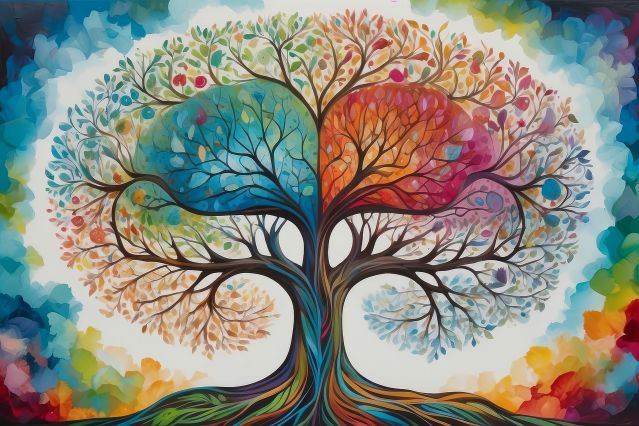Emotions
How Does the Brain Actually Produce Emotions?
Exploring constructionist and predictive coding theories of emotion.
Updated September 15, 2024 Reviewed by Jessica Schrader
Key points
- Constructionist theory says emotions are high-level cognitive constructs shaped by experience and culture.
- Other theories maintain that emotions have a more innate, hard-wired, and universal basis.
- Emotions might also be shaped by the brain’s predictive processes, rather than being purely reactive.

This is Part 3 of a four-part series on: What Actually Are Emotions?
“Emotions are not what we think they are. They are not universally expressed and recognized. They are not hardwired brain reactions that are uncontrollable.” — Lisa Feldman Barrett (2017)1
Lisa Feldman Barrett’s theory of constructed emotion
The neuroscientist and psychologist Lisa Feldman Barrett has spent much of the later part of her career trying to convince the scientific and wider community that the “basic emotions” theory we discussed in Part 2—the “classic” view of emotions—is dead wrong. Those theories, as we saw, hold that there are core emotions that are basically hardwired and innate, produced by subcortical brain circuits. Basic emotions theory considers those core emotions to be universal to all humans and also many animal species.
In contrast, Feldman Barrett argues that emotions are not innate or universal but are constructed through higher cognitive processes in the cerebral cortex, integrating basic affective states2 with conceptual knowledge. Her “constructionist” theory of emotion can be thought of as a type of cognitive theory of emotion (of which there are several others), in that it emphasizes the role of cognitive processes. These processes are carried out mainly in the cortex, rather than in the deeper, more ancient subcortical regions of the brain. And rather than dedicated brain circuits for each emotion, as proposed by Jaak Panksepp (discussed in Part 2), constructionist theory maintains that emotions are the result of dynamic interactions across multiple brain regions.3 Cognitive theories of emotion, including Feldman Barrett’s constructionist theory, view emotions as mutable, and variable across individuals, not innate and universal.
In constructionist theory, emotions are not pre-programmed responses but are constructed by the brain through a complex interplay of physiological states, contextual factors, past experience (learning), conceptual knowledge, and cultural influences. Emotions are influenced by an individual’s unique experiences and context, their understanding of the situation, and their ability to label and interpret their emotional responses.
Ralph Adolphs’s critique of constructionist theory, and his functional view of emotions
The neuroscientist Ralph Adolphs (quoted in Part 1) criticizes constructionist theory for lacking objective criteria, underemphasizing evolutionary functions of emotions, and being too broad in its explanations. He takes a functional view of emotions, meaning that they can be defined and categorized based on their roles or purposes—what they do—rather than their physical or subjective manifestations. Specifically, he views emotions as states of the brain that have evolved to solve particular problems related to survival and reproduction. These states trigger specific behavioral and physiological responses that help an organism adapt to its environment. For example, the emotion of fear, in a functional view, is defined by its role in preparing an organism to respond to threats (e.g., by triggering the fight-or-flight response). The focus is on the cause (perceiving a threat) and the effect (engaging in defensive behavior). He contends that these can be objectively measured, unlike constructionist theory, which he believes relies too heavily on subjective inferences and social constructs, weakening its scientific rigor.4
Adolphs maintains that evidence from animal studies supports the view that certain emotional responses, like fear and aggression, are linked to specific, evolutionarily conserved neural circuits that are similar across species, particularly in mammals. He agrees that emotions are not entirely hard-wired or confined to subcortical circuits—many emotional processes involve broader neural networks and are influenced by both innate mechanisms and contextual factors.5
Adolphs’s theory of emotions is not simply aligned with basic emotions theory (as outlined in Part 2), as his theory also includes an important role for higher-order cognitive appraisals and interpretations of basic emotions in producing conscious feelings. His theory is an integrative approach that bridges basic emotions with higher-order cognitive processes.6
The role of predictive coding in emotion
Feldman Barrett’s theory incorporates another key feature—predictive coding, whose merits are independent of the above debate. Predictive coding is increasingly central to broader theories of brain function. The basic idea is that the brain continuously generates hypotheses or predictions about incoming sensory information based on past experiences (as well as developmental and evolutionary histories), compares its predictions to actual sensory inputs as events unfold, and generates prediction errors when discrepancies arise. The brain then updates its predictions to minimize these errors, creating a dynamic feedback loop. These predictions are not limited to the external environment but also include internal bodily states (interoception7). Feldman Barrett proposes that this is how emotions are constructed. In this view, emotions are products of an internal model that is predictive rather than reactive.8,9
Anil Seth’s interoceptive inference theory of emotions
Like Feldman Barrett, neuroscientist Anil Seth views emotions as constructed from the brain's interpretation of interoceptive and sensory signals. His framework is deeply grounded in the idea of the brain as a prediction machine.10
Seth suggests that affective experiences can be understood as distinctive kinds of “controlled hallucinations.” He posits that the brain makes predictions, or best guesses, about its internal state—a concept he terms “interoceptive inference.”11
Although Seth’s theory is not traditionally labeled as "constructionist," it shares similarities with that approach. His concept of interoceptive inference proposes that the brain constructs emotions by predicting bodily states and interpreting sensory inputs, aligning with the idea that emotions are not pre-programmed (as suggested by basic emotions theory) but are shaped by the brain's interpretations.
Both Seth and Feldman Barrett emphasize the importance of how predictive models can be used for physiological regulation.12
Seth’s theory emphasizes the neural mechanisms underlying interoceptive inference, drawing on neurophysiological evidence to support his claims. Unlike Feldman Barrett, his theory is less focused on the role of conceptual knowledge from past experiences, language, and social constructs in the construction of emotions.13
Seth adopts an integrative approach to the roles of subcortical and cortical influences on emotion. He suggests that affect is generated in the subcortex and emotions are elaborated in the cortex, but he does not focus on strictly differentiating these regions’ respective roles.14
In previous posts, I have explored the deep insights into consciousness and the nature of the “self” provided by Seth’s theory.
Integration
As can be seen, there are competing theories regarding the extent to which emotions are innate, hard-wired, and universal, versus constructed by high-level cognitive processes, experience and culture. And while there is increasing recognition that predictive coding plays an important role generally in how the brain functions, its role in emotions more specifically awaits confirmation.
The science of emotion may ultimately be informed by an integration of elements of these various theories.
In Part 4, we will discuss other integrative theories of emotion and consider their implications for understanding consciousness.
References
1. Barrett, L. F. (2017, April). You aren't at the mercy of your emotions — Your brain creates them [Video]. TED Conferences. https://www.ted.com/talks/lisa_feldman_barrett_you_aren_t_at_the_mercy_of_your_emotions_your_brain_creates_them.
2. Defined simply by high or low arousal, and positive or negative valence.
3. While Feldman Barrett acknowledges the role of subcortical structures like the amygdala, her theory places more emphasis on distributed brain networks and the cortex's role in constructing emotions. These brain regions and networks include many of the ones listed in Footnote 10 of Part 1 and in the last paragraph of Footnote 5 in Part 2.
[Click 'More' to view footnotes 4-14].
4. Feldman Barrett counters that attempts at objective criteria for emotions would be inherently context-dependent and socially constructed. She argues that the same physiological responses can lead to different emotions (e.g., what one person perceives as fear, another might perceive differently), reflecting the variability and social context central to her theory. [Adolphs, R., Mlodinow, L., & Barrett, L. F. (2019). What is an emotion? Current Biology, 29(20), R1060–R1064. https://doi.org/10.1016/j.cub.2019.09.008.]
5. Adolphs agrees with Barrett that the traditional categories of emotions, such as “anger” and “fear,” need revision. He acknowledges that these categories, as they stand, are not sufficiently precise and that better criteria are required to identify what qualifies as an emotion. He supports the idea that emotions should not be understood as rigid, universal categories but as more flexible constructs. However, he expresses concern over what he perceives as Feldman Barrett’s potential leaning towards radical relativism—wherein emotion categories are entirely socially constructed concepts. He is cautious about endorsing such a view, preferring a middle ground where emotions, while not universally fixed, still require some objective criteria for categorization. [Adolphs, R. (2017). Reply to Barrett: Affective neuroscience needs objective criteria for emotions. Social Cognitive and Affective Neuroscience, 12(1), 32–33. https://doi.org/10.1093/scan/nsw155.]
6. Adolphs argues for “a functionalist approach to emotion that begins by focusing on emotions as central states with causal connections to behavior and to other cognitive states.” Emotions are positioned between reflexes (simple, automatic responses) and deliberated behaviors (complex, conscious decisions). They provide a level of control that is more flexible than reflexes but less deliberative than fully conscious actions. Distinguished by features such as persistence, generalization, semiflexibility, automaticity, adaptive behavior generation, and specific causal roles in relation to other cognitive states, emotions occupy a unique position that sets them apart from both reflexes and fully volitional cognitive processes. [Adolphs, R., & Andler, D. (2018). Investigating emotions as functional states distinct from feelings. Emotion Review, 10(3), 191–201. https://doi.org/10.1177/1754073918765662.]
7. The term interoception refers to perception of sensory signals that originate from within the body, especially in the gut and other internal organs, as opposed to exteroception, which refers to perception of stimuli from the external environment.
8. Barrett, L. F. (2017). How emotions are made: The secret life of the brain. Houghton Mifflin Harcourt; Barrett, L. F. (2017). The theory of constructed emotion: An active inference account of interoception and categorization. Social Cognitive and Affective Neuroscience, 12(1), 1–23. https://doi.org/10.1093/scan/nsw154.
9. Ralph Adolphs agrees that predictive coding is a valid concept, but he contends that it is not specific to emotions. He suggests that while predictive coding might be a component of how the brain functions broadly, it doesn’t necessarily provide a complete or specific explanation for how emotions are generated. He advocates for more concrete, objective criteria for studying emotions, emphasizing the importance of grounding emotion research in observable and measurable phenomena rather than relying solely on theoretical constructs. Such criteria should include behavioral observation, neurobiological markers, physiological indicators, evolutionary and functional criteria, cross-species comparisons, and consensus-based definitions. [Adolphs, R. (2017). Reply to Barrett: Affective neuroscience needs objective criteria for emotions. Social Cognitive and Affective Neuroscience, 12(1), 32–33. https://doi.org/10.1093/scan/nsw155.]
10. Seth puts it this way: "Instead of perception depending largely on signals coming into the brain from the outside world, it depends as much, if not more, on perceptual predictions flowing in the opposite direction. We don't just passively perceive the world, we actively generate it. The world we experience comes as much, if not more, from the inside out as from the outside in." [Seth, A. (2017, April). Your brain hallucinates your conscious reality [Video]. TED Conferences. https://www.ted.com/talks/anil_seth_your_brain_hallucinates_your_conscious_reality]
11. Similar to Feldman Barrett, Seth’s theory suggests that emotions are the brain’s interpretations of physiological states, shaped by predictions and sensory inputs to maintain homeostasis.
12. Both Feldman Barrett and Seth argue that a key feature of predictive processing as applied to interoception and emotion is the potential for homeostatic / allostatic control. For Seth, it is this role that confers on interoceptive inferences their characteristic phenomenology [Homeostasis is about maintaining stability by keeping the body's internal environment within a narrow, fixed range (e.g., body temperature, blood sugar). Allostasis is about achieving stability through change, where the body dynamically adjusts its internal environment based on predicted or actual demands, adapting to stress or changing conditions. Homeostasis focuses on maintaining constancy, while allostasis emphasizes flexibility and anticipation.
13. Also, his theory does not explicitly focus on core affect (dimensions of arousal and valence) as foundational elements the way that Feldman Barrett does.
14. Personal communication, July 4, 2024.




